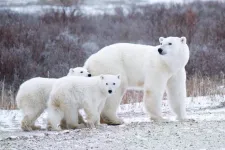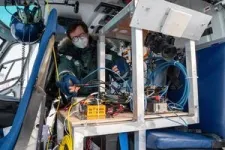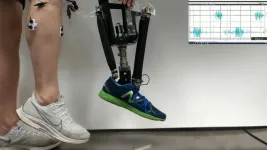(Press-News.org) Research testing new technology to more effectively locate polar bear dens across the Arctic is showing promising results. Researchers from Simon Fraser University and Brigham Young University (BYU), collaborating with Polar Bears International, hope that improving detection tools to locate dens—which are nearly invisible and buried under snow—will help efforts to protect mother polar bears and their cubs.
Results of a pilot study aimed at improving den location in Churchill, Manitoba—using ARTEMIS Inc., an imaging system that relies on Synthetic Aperture Radar, or SAR—are published this week in the journal URSUS just ahead of Polar Bear Week (Oct. 29 - Nov. 4).
The team found that SAR increased den detection by more than 20 per cent, or 66 per cent, compared with the industry’s current 45 per cent accuracy rate using the aerial Forward Looking Infrared (FLIR) system as a den-detection tool.
"Our airborne imaging radar system has multi-band, interferometric, and polarization capabilities at microwave frequencies able to penetrate snow,” says SFU engineering science professor Bernhard Rabus, who holds an Industrial Research Chair in Synthetic Aperture Radar. “The system can ‘see’ both the top snow surface, the den roof surface and inside the den cavity."
“While our method is still in its research and testing phase, an operational version is expected to be able to extrapolate from the radar signatures of live bears in the open, combined with computer modelled den cavity radar signatures, to develop a robust match filter detection for airborne multi-channel SAR data to detect polar bears reliably inside their dens."
Unlike aerial FLIR, SAR technology performs well regardless of temperature and weather conditions, which is crucial in the Arctic, thus SAR may be an effective tool to guide conservation efforts for this vulnerable and iconic species.
“This report advances Synthetic Aperture Radar as a promising method for polar bear den detection, which is critical for protecting polar bears alongside human activity,” says Geoff York, senior director of research and policy at Polar Bears International. “Brigham Young University and Simon Fraser University have been invaluable research partners, and we’re excited about the possibility of SAR in the Arctic as it performs well in all weather conditions.”
David Long, electrical engineering professor and director of BYU’s Center for Remote Sensing, noted that the research provided BYU undergraduate Capstone students “an opportunity to do original research to identify and locate polar bears using radar. This is the first time this has ever been done, and we have great confidence this can be used in the arctic areas to detect polar bears in the snow.”
Denning is the most vulnerable time for polar bears, and with increased industry activity in the region, there is a need for more accurate tools that can detect polar bear dens to avoid disturbing them during this critical time.
Polar bears cubs are born blind with only a light layer of fur to protect them from the cold. They remain dependent on their mothers, living in winter dens under the snow. They are able to emerge from the den in spring when they have grown enough to withstand the harsh Arctic conditions.
A mother bear’s inability to successfully raise cubs contributed to the 40 per cent decline of the Southern Beaufort Sea subpopulation between 2000-2010. A critical part of polar bear conservation is keeping mothers and cubs safe while also addressing other threats such as climate change.
About Simon Fraser University
As Canada’s engaged university, SFU works with communities, organizations and partners to create, share and embrace knowledge that improves life and generates real change. We deliver a world-class education with lifelong value that shapes change-makers, visionaries and problem-solvers. We connect research and innovation to entrepreneurship and industry to deliver sustainable, relevant solutions to today’s problems. With campuses in British Columbia’s three largest cities—Vancouver, Burnaby and Surrey—SFU has eight faculties that deliver 364 undergraduate degree programs and 149 graduate degree programs to more than 37,000 students. The university now boasts more than 180,000 alumni residing in 145+ countries.
About Polar Bears International
Polar Bears International’s mission is to conserve polar bears and the sea ice they depend on. The organization works to inspire people to care about the Arctic, the threats to its future, and the connection between this remote region and our global climate. Polar Bears International is the only nonprofit organization dedicated solely to wild polar bears and Arctic sea ice, and the staff includes scientists who study wild polar bears. The organization is a recognized leader in polar bear conservation. For more information, visit www.polarbearsinternational.org.
END
Protecting polar bears aim of new and improved radar technology
2023-10-18
ELSE PRESS RELEASES FROM THIS DATE:
From one nightmare to another. Anthony Fauci’s new concern
2023-10-18
(WASHINGTON) -- “What keeps you up at night?”
It’s a question Anthony Fauci, MD, heard repeatedly over the course of his nearly four decades as director of the National Institute of Allergy and Infectious Diseases at the National Institutes of Health.
Now a Distinguished University Professor at Georgetown University School of Medicine and the McCourt School of Public Policy, Fauci says he realized his worst nightmare -- a twist on the usual question -- in January 2020 when the type of virus he most feared triggered a worldwide pandemic.
Today, as the COVID-19 pandemic wanes, Fauci describes a new nemesis ...
Robotic prosthetic ankles improve ‘natural’ movement, stability
2023-10-18
Robotic prosthetic ankles that are controlled by nerve impulses allow amputees to move more “naturally,” improving their stability, according to a new study from North Carolina State University and the University of North Carolina at Chapel Hill.
“This work focused on ‘postural control,’ which is surprisingly complicated,” says Helen Huang, corresponding author of the study and the Jackson Family Distinguished Professor in the Joint Department of Biomedical Engineering at NC State and UNC.
“Basically, when we are standing still, ...
New study suggests promising approach for treating pancreatic cancer
2023-10-18
A new study carried out in mice, led by Queen Mary University of London, has identified cells that drive the spread of pancreatic cancer and discovered a weakness in these cells that could be targeted using existing drugs. This offers a promising new approach for treating pancreatic cancer.
The research, published in Science Advances and funded by Barts Charity and Cancer Research UK, found that many patients' pancreatic cancer contains cells called amoeboid cells. These are aggressive, invasive ...
The encounter between Neanderthals and Sapiens as told by their genomes
2023-10-18
About 40,000 years ago, Neanderthals, who had lived for hundreds of thousands of years in the western part of the Eurasian continent, gave way to Homo sapiens, who had arrived from Africa. This replacement was not sudden, and the two species coexisted for a few millennia, resulting in the integration of Neanderthal DNA into the genome of Sapiens. Researchers at the University of Geneva (UNIGE) have analyzed the distribution of the portion of DNA inherited from Neanderthals in the genomes of humans (Homo sapiens) ...
Migrants in Denmark face disparities in care for type 2 diabetes
2023-10-18
A large, population-wide study of Denmark residents with type 2 diabetes shows that migrants typically face a greater risk of inferior care for their disease than native Danes, particularly when it comes to monitoring their disease and controlling biomarkers—managing blood levels of key substances that are associated with diabetes. Anders Aasted Isaksen of Aarhus University and Steno Diabetes Center Aarhus, Denmark, and colleagues present these findings in the open-access journal PLOS Global Public Health.
Prior research ...
Drought conditions expose rivers to hotter water temperatures
2023-10-18
As climate change warms the planet and droughts are anticipated to become more frequent and extreme, a new study reveals how reduced water flows and rising atmospheric temperatures are set to heat our rivers - creating major challenges for aquatic life, ecosystems, and society.
Water temperature is an important control for all the physical, chemical, and biological processes in rivers. It is particularly important for organisms that cannot regulate their own body temperature, such as fish. River temperature is important for human health and industrial, domestic, and recreational ...
The right to be forgotten: ESMO calls on EU countries to ensure equal financial rights for cancer survivors
2023-10-18
ESMO calls on EU member states to adopt a five-year threshold for cancer survivors’ right to be forgotten when transposing the revised EU Consumer Credits Directive to their national legislation
The Society has been selected as one of the key stakeholders involved in the development of the EU Code of Conduct which seekS to ensure that advances in cancer care are reflected in the commercial practices of financial service providers
The ESMO Patient Advocacy Working Group aims to launch a pan-European campaign to illustrate to decision-makers the life-changing impact of a simple ...
Researchers uncover mechanism that links NAD+ to fertility problems
2023-10-18
A woman’s fertility normally decreases by her late 30s with reproductive function eventually ceasing at menopause. It is known that a small molecule called nicotinamide adenine dinucleotide (NAD+) plays a critical role in this decline, and Buck scientists have revealed how this happens and have identified potential new approaches to enhance reproductive longevity.
“Studying ovarian biology and reproductive aging is not just about trying to increase fertility, but really about the overall ...
Study elucidates evolution of mosquitoes and their hosts
2023-10-18
Researchers at North Carolina State University and global collaborators have mapped the mosquito’s tree of life, a major step toward understanding important traits, such as how the insects choose their hosts, feed on blood and spread disease. The findings will help researchers make better predictions to model disease transmission and understand what makes some mosquitoes better disease carriers than others.
The research suggests that mosquito evolution over the past 200 million years mirrors the Earth’s ...
Fighting antimicrobial resistance with new drug combinations
2023-10-18
Antimicrobial resistance – occurring when pathogens can survive antibiotic treatment – is one of the most rapidly emerging global public health threats today. According to a 2022 study, nearly five million deaths were associated with antibiotic-resistant bacteria in 2019, with over a million deaths per year directly attributable to antimicrobial resistance.
In a new study, researchers from the Typas Group at EMBL Heidelberg have systematically profiled over 10,000 drug combinations for their effectiveness against common multidrug-resistant bacteria.
“Previously, ...



